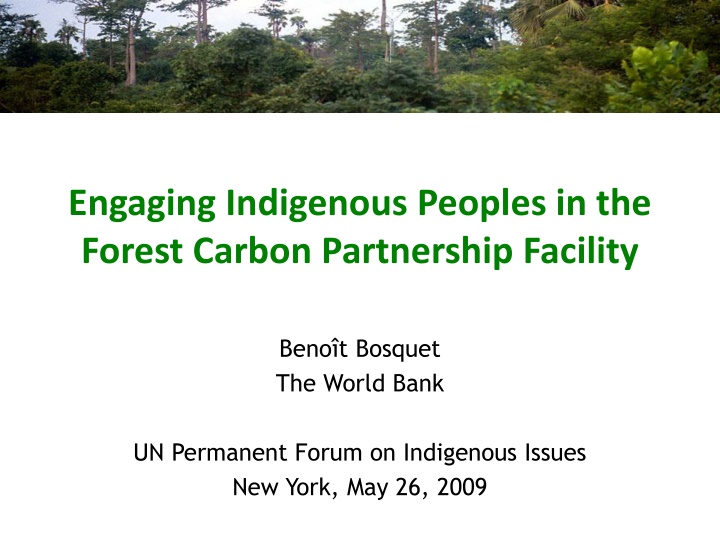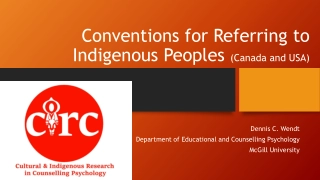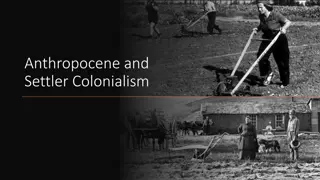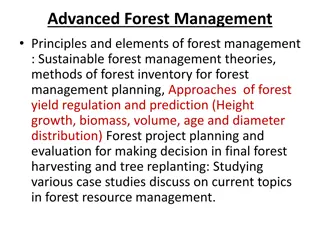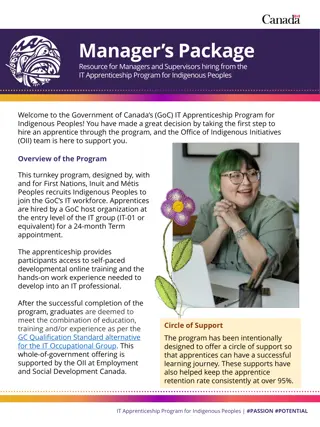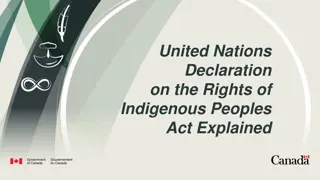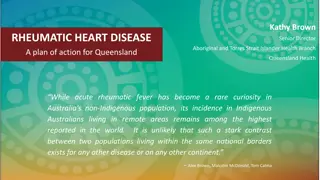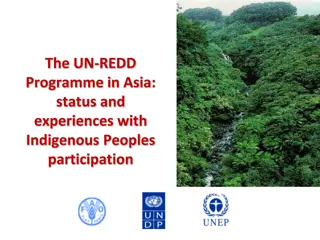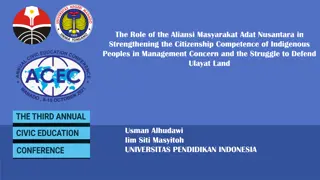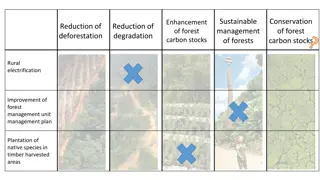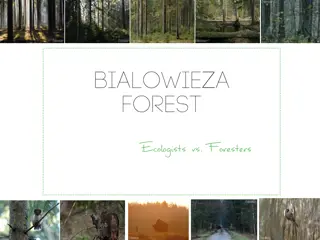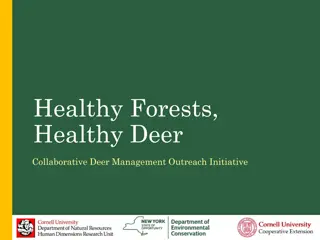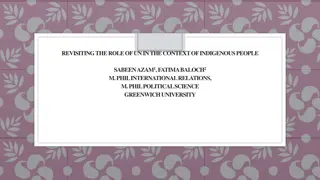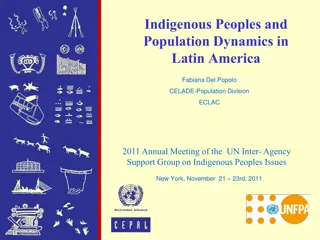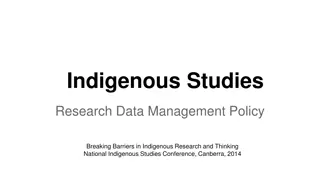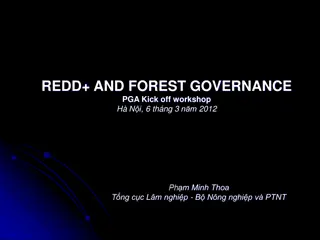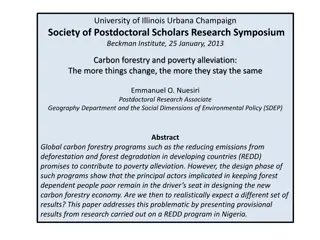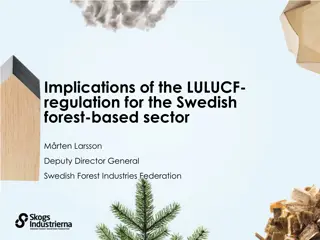Engaging Indigenous Peoples in Forest Carbon Partnership
Quick Introduction to REDD, Forest Carbon Partnership Facility, and the role of Indigenous Peoples. Learn about REDD and its significance in climate change mitigation, emphasizing the importance of forests. Understand the forest transition path and the need to implement REDD at the national level for effective outcomes.
Download Presentation

Please find below an Image/Link to download the presentation.
The content on the website is provided AS IS for your information and personal use only. It may not be sold, licensed, or shared on other websites without obtaining consent from the author.If you encounter any issues during the download, it is possible that the publisher has removed the file from their server.
You are allowed to download the files provided on this website for personal or commercial use, subject to the condition that they are used lawfully. All files are the property of their respective owners.
The content on the website is provided AS IS for your information and personal use only. It may not be sold, licensed, or shared on other websites without obtaining consent from the author.
E N D
Presentation Transcript
Engaging Indigenous Peoples in the Forest Carbon Partnership Facility Beno t Bosquet The World Bank UN Permanent Forum on Indigenous Issues New York, May 26, 2009
Outline of the Presentation 1. Quick Introduction to REDD 2. The Forest Carbon Partnership Facility 3. Indigenous Peoples and the FCPF
What is REDD? Reducing Emissions from Deforestation and Forest Degradation in Developing Countries Attempt to recognize role of forests in climate change mitigation Forests are needed to achieve +2 C objective 20% of the problem 20% of the solution? Discussed in UNFCCC negotiations as part of post-2012 climate regime Excluded from Clean Development Mechanism Allowed for Annex I countries and under Joint Implementation
Following traditional development paths, most countries lose most of their native forests North Amazon Basin Congo Basin National forest cover South Amazon Basin Europe North America South East Asia North East Asia South Asia West Africa Oceania Atlantic forest Time Source: REDD OAR, 2009
REDD can form a bridge on forest transition path National forest cover REDD bridge Forest transition path Time Source: REDD OAR, 2009
REDD: National or Sub-national? For the bridge to be built, REDD should be at the heart of national development policy REDD is not a substitute for development policies Other reasons REDD should be handled at the national level Projects may not achieve necessary scale Leakage from projects Benefit-sharing mechanisms may be necessary REDD implementation may have to start at sub- national level to gain experience and before sufficient financing is available
REDD or REDD plus? Bali Action Plan calls for policy approaches and positive incentives on issues relating to reducing emissions from deforestation and forest degradation in developing countries; and the role of conservation, sustainable management of forests and enhancement of forest carbon stocks in developing countries . A broader definition of REDD adds methodological and financial issues, but removes perverse incentives Limiting financial compensation to reduced deforestation/degradation may discourage early action
The Three Phases of REDD Payments Performance-based Maintenance FCPF Carbon Fund, Norway, GFCM (?), carbon market (?) Institution strengthening Forest governance and information Sustainable forest management Investments outside forest sector Capacity, Reforms & Investments FIP, UN-REDD, CBFF, GEF, ODA, AAU set-aside, REDD Bonds (?) Assessment of situation Reference Scenario REDD Strategy Monitoring System Readiness FCPF Readiness Fund, UN-REDD, CBFF, GEF, ODA
Indigenous Peoples and REDD Anchorage Declaration (April 24, 2009), para. 5: All initiatives under Reducing Emissions from Deforestation and Degradation (REDD) must secure the recognition and implementation of the human rights of Indigenous Peoples, including security of land tenure, ownership, recognition of land title according to traditional ways, uses and customary laws and the multiple benefits of forests for climate, ecosystems, and Peoples before taking any action.
Risks and Opportunities of REDD Risks Opportunities Will investments and payments weaken customary rights and access to land/ natural resources? Can Indigenous Peoples and other forest dwellers participate in the development of REDD schemes? Who owns the carbon? Who will be paid? Will investments affect livelihoods and cultures? What is the economic future of small and medium-size enterprises and local markets? New sources of revenues Clarification of rights Insert local knowledge and practice into global system Monitoring Verification Enforcement Recognition of the contributions of forests people to climate regulation Enhanced participation in political processes
What is the FCPF? One of the REDD demonstration activities called for by Bali Action Plan G8 initiative (Heiligendamm, 2007) Support from 40+ developing countries Partnership + Facility
FCPF: From REDD Readiness to REDD Payments Carbon Finance Mechanism Readiness Mechanism CARBON FUND READINESS FUND Capacity Building (2008-2012) Payments for Emission Reductions (2010-?) ~$185 million ~$200 million
Roles of FCPF, UN-REDD and FIP FCPF UN-REDD Readiness, Quick start Capacity building, Institution strengthening & Local action FIP Large scale, transformational investment programs FCPF Carbon fund
Countries Participating in FCPF Africa South America Argentina Bolivia Chile Colombia Guyana Paraguay Peru Suriname Southeast Asia & Pacific Cambodia Indonesia Lao PDR Papua New Guinea Thailand Vanuatu Vietnam Cameroon Central African Republic Dem. Republic of Congo Equatorial Guinea Ethiopia Gabon Ghana Kenya Liberia Madagascar Mozambique Republic of Congo Tanzania Uganda Meso America Costa Rica El Salvador Guatemala Honduras Mexico Nicaragua Panama South Asia Nepal
The 3 Phases of FCPF Operations Main Documents and Milestones Legal Agreements and Financial Commitments OPTIONAL: $0.2 m Grant Agreement for R-PFP preparation $3.6 m Grant Emission Reductions Payment Agreement Agreement for R-PFP implementation -1- -2- -3- Proposal Formulation Preparing for Readiness Emission Reductions Program Investments (FIP, etc.) R-PFP R-Plan R-PIN Country selection R-PFP assessment & authorization to allocate Readiness Grant Assessment of Readiness Emission Reductions Program Selection in Carbon Fund Readiness Fund Carbon Fund
All 37 Countries are Here All have submitted a Readiness Plan Idea Note (R-PIN) Some of them have obtained a $0.2 million grant to develop their Readiness Preparation and Funding Proposal (R-PFP) Three have submitted a R-PFP OPTIONAL: $0.2 m Grant Agreement for R-PFP preparation $3.6 m Grant Agreement for R-PFP implementation -1- -2- -3- Proposal Formulation Preparing for Readiness Emission Reductions Program R-PFP R-Plan R-PIN Country selection R-PFP assessment & authorization to allocate Readiness Grant Assessment of Readiness Emission Reductions Program Selection in Carbon Fund Readiness Fund Carbon Fund
Information Exchanges Held with Forests People 3 regional meetings prior to start of operations Kathmandu Bujumbura La Paz Exchanges in conferences or during country visits Barcelona Marrakech Bali Nairobi Kinshasa Anchorage Accra Panama
Indigenous Representatives in FCPF Governance PARTICIPANTS COMMITTEE REDD COUNTRIES Bolivia DRC Gabon Ghana Guyana Madagascar Mexico Nepal Panama Vietnam CONTRIBUTORS AFD (France) Australia Germany Japan Netherlands Norway Switzerland TNC United Kingdom United States TECHNICAL ADVISORY PANELS Indigenous Representatives OBSERVERS Forests People, International Organizations, NGOs, UNFCCC Secretariat, UN-REDD Programme, Private Sector
Capacity Building Program for Indigenous Peoples Provide small grants to Indigenous Peoples organizations to build capacity on REDD at regional and national levels. Grants allocated based on proposals received from indigenous organizations and managed by them: COICA (Amazonia)- organize regional level workshops and will produce a reference document on REDD as contribution towards Copenhagen IPACC (Africa)- organize regional and national level workshops and will produce toolkit on REDD to be used for training of trainers at country level COONAPIP (Panama)- organize 11 workshops for informational exchanges and arriving at common position on REDD and government s proposal to the FCPF New proposals can be funded starting July 1, 2009
Role of Observer for Forests People (Forest Dependent Indigenous Peoples and Other Forest Dwellers) Rights and Responsibilities: Full participation in meetings Full access to information prior to meetings Costs of attending meetings covered for 1 person Up to 3 persons represented at meeting Budget for organizing input-output process between forests peoples and FCPF Selection: Work with International Alliance of Indigenous and Tribal Peoples of Tropical Forests to Organize selection process and manage budget no World Bank prescription Serve as interim Observer
Forests Peoples Involvement at Country Level Requirement that Indigenous Peoples will be consulted and participate in FCPF operations: World Bank Safeguard Policy 4.10 FCPF guidance note on Consultation and Participation http://www.forestcarbonpartnership.org/fcp/sites/forestcarbonpartnership.org/files/FCPF_FMT_Note_2009- 2_Consult_Particip_Guidance_05-06-09_0.pdf Consultation and participation requirements start applying at Proposal Preparation stage, i.e., now. Participation means participation in a national process, to design country-specific solutions to REDD Participation of Indigenous Peoples in REDD processes is purely voluntary
THANK YOU FOR YOUR ATTENTION MERCI POUR VOTRE ATTENTION GRACIAS POR SU ATENCION www.forestcarbonparnership.org
